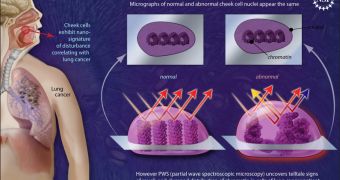Lung cancer can now be easily detected thanks to a new method pioneered by researchers in the United States. All that's needed for a diagnostic to be made is a simple cheek swab, researchers say.
Though its one of the deadliest forms of cancer overall, this condition is notoriously difficult to identify in its earliest stages. But picking up on its existence from the get-go increases survival rates.
As such, the new detection method, which only relies on analyzing cheek swabs, may become an indispensable tool for healthcare experts seeking to discover the disease early on.
If early detection of lung cancer becomes possible, then numerous lives that the condition would otherwise claim each year could be saved.
The new method was pioneered by researchers from the NorthShore University Health System, the Northwestern University, and New York University.
Details of the investigation appear in the October 15 issue of the esteemed journal Cancer Research.
“This study is important because it provides the proof of concept that a minimally intrusive, risk-stratification technique may allow us to tailor screening for lung cancer, the leading cause of cancer deaths in Americans,” says scientist Hemant Roy.
He holds a joint appointment as a physician and a researcher at the NorthShore University HealthSystems and the University of Chicago, and is also the lead author of the study paper.
“This represents a major step forward in translating biomedical optics breakthroughs for personalized screening for lung cancer,” Roy goes on to say.
The new technique is called partial wave spectroscopic (PWS) microscopy, and it is able to differentiate individuals with lung cancer from those without by shining diffuse light on samples taken via cheek swabs.
This approach is so effective that it can tell non-cancerous patients apart from sick ones even if the former are lifetime smokers, or suffer from chronic obstructive pulmonary disease (COPD).
“Their work has now transitioned to a larger $2 million Emerging Frontiers in Research and Innovation award,” explains Leon Esterowitz.
“The results have even larger implications in that the techniques and the ‘field effect' may be a general phenomena that could be applied to a multitude of epithelial cancers, the most common cancer type,” he adds.
Esterowitz is the program director at the US National Science Foundation. The NSF has been supporting this research with grants since 2002.

 14 DAY TRIAL //
14 DAY TRIAL //